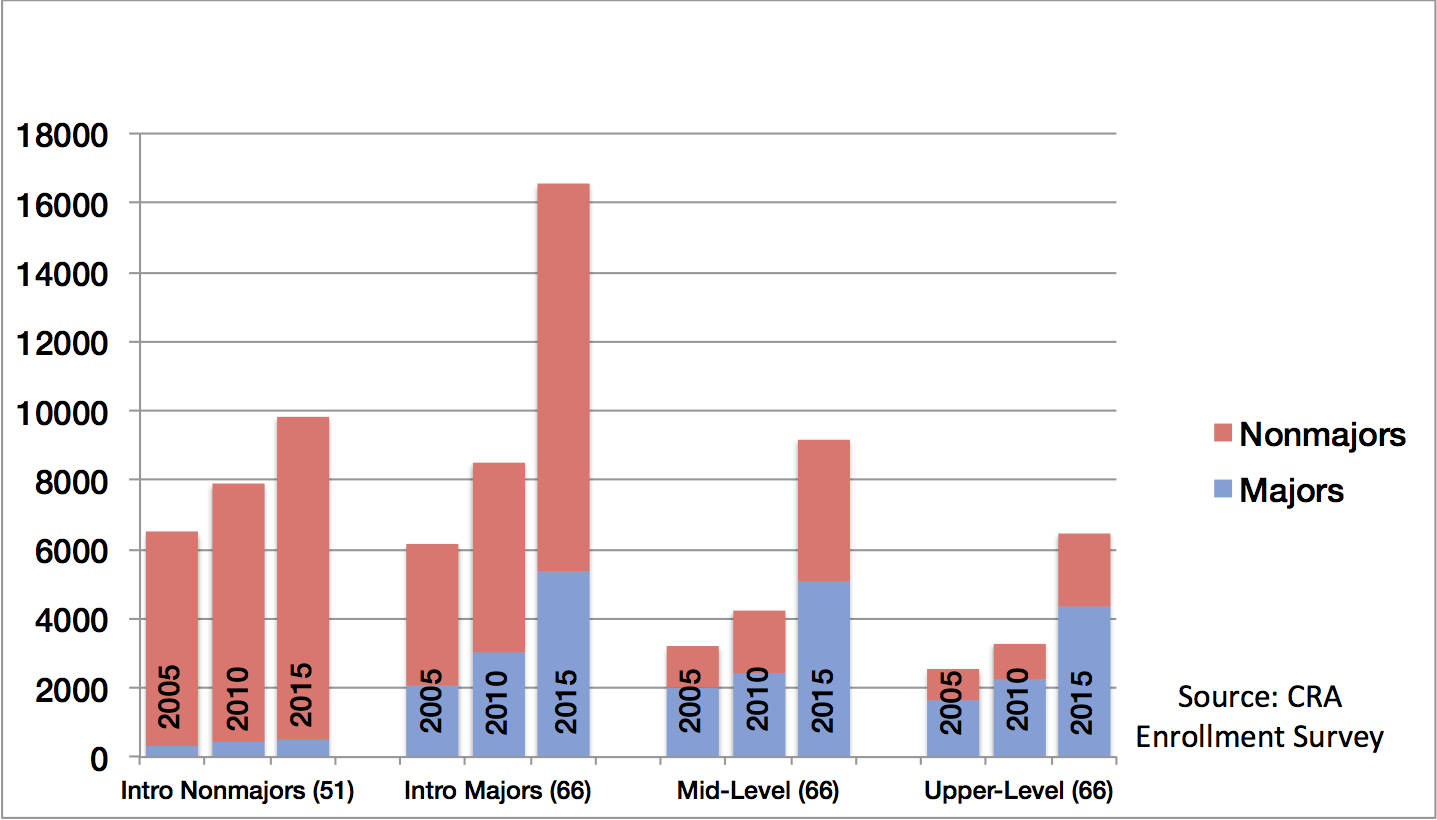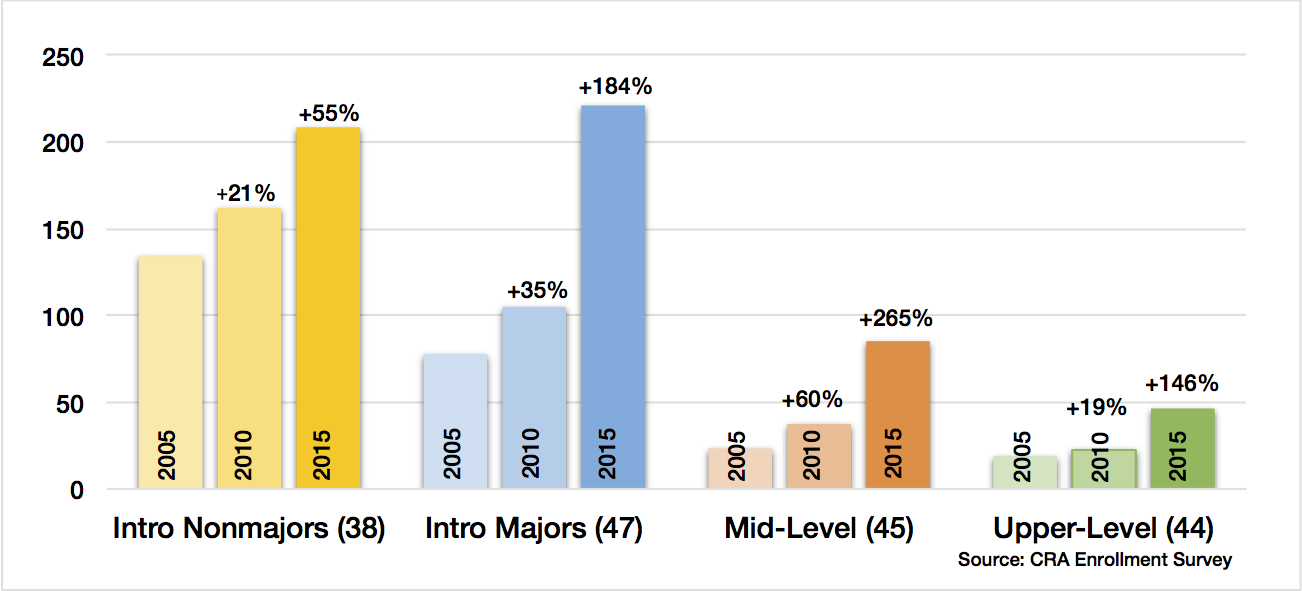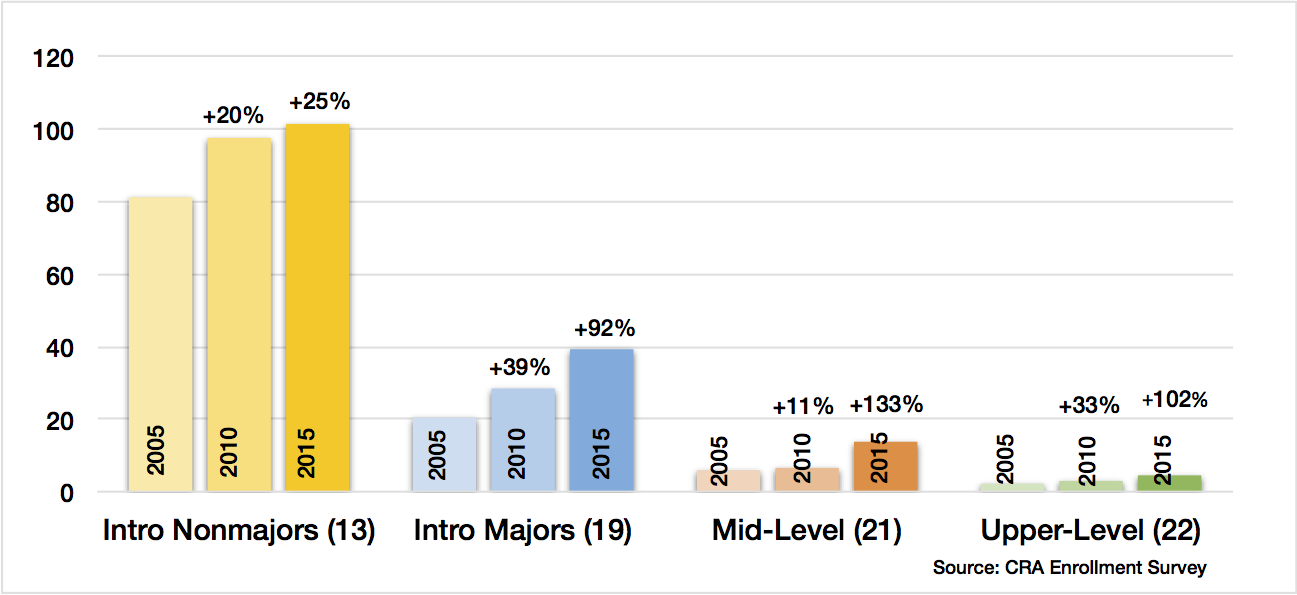C. The Widespread Increase in Nonmajor Enrollment
In addition to a phenomenal increase in computer science majors [B. Growth of CS Majors], there is a large increase in the number of nonmajors taking computing courses. Increases in the number of nonmajors are occurring throughout the curriculum (i.e., at the introductory course level, in mid-level courses, and in upper-level courses). Any analysis that only considers the growth of computer science majors therefore underrepresents the increased demand that units[1] are trying to meet. In order to fully understand the demand that exists, we need to also consider the large increase of nonmajors taking computing courses.
An overview of the nonmajor growth in computing courses, based on courses surveyed from both doctoral- and non-doctoral granting units, can be found in Figure C.1 (see [A. CRA Committee] and [H. Methodology] for details on the course data collected). Between 2005 and 2015, in representative courses primarily intended for majors, the number of nonmajors in computing courses increased at a rate equal to or greater than the increase in majors. For the intro majors course, majors increased by 152% and nonmajors by 177%; for the mid-level course, majors increased by 152% and nonmajors by 251%; and for the upper-level course, majors increased by 165% and nonmajors by 143%. This data is from both the doctoral- and non-doctoral granting units that responded to the CRA Enrollment Survey.

Figure C.1: Cumulative nonmajor enrollment (red) and major enrollment (blue) in computing courses at doctoral- and non-doctoral granting units from 2005 to 2015. The number in parentheses in each category indicates sample size.
In the following, we consider these increases separately for doctoral and non-doctoral granting units. Specifically, Figure C.2(a) summarizes the mean enrollments in each course category for doctoral-granting units, and Figure C.2(b) summarizes the mean enrollments in each course category for non-doctoral granting units.

(a) Doctoral-Granting Units

(b) Non-Doctoral Granting Units
Figure C.2: Average enrollment by nonmajors in computing courses at doctoral- and non-doctoral granting units from 2005 to 2015.
The number in parentheses in each category indicates sample size.
Introductory Courses
As discussed in [A. CRA Committee], data was collected from institutions for two types of introductory courses: an intro-level course mainly for nonmajors and an intro-level course mainly for majors. At doctoral-granting units, mean enrollment by nonmajors in the representative intro-level course for nonmajors had an increase of 55% from 2005 to 2015 (38 respondents). Enrollment by nonmajors in the representative intro-level course for majors had a much larger increase of 184% (47 respondents).
Non-doctoral granting units have also seen growth (from 2005 to 2015) in the number of nonmajors taking both types of introductory courses; the growth, however, is somewhat less dramatic than the growth seen at doctoral-granting units: a 25% increase in the intro-level course for nonmajors (13 respondents) and a 92% increase in the intro-level course for majors (19 respondents). We note, however, that the sample size is small, especially when one considers the large number of non-doctoral granting units that exist; in other words, as mentioned in [B. Growth of CS Majors], more study of non-doctoral granting units is needed to fully understand the situation at the diverse set of non-doctoral granting units.
Mid-Upper Level Courses
The growth in mid-level and upper-level courses from 2005 to 2015 due to nonmajors was also phenomenal at doctoral-granting units. Specifically, the number of nonmajors in mid-level courses grew by 265% (45 respondents) and the number of nonmajors in upper-level courses grew by 146% (44 respondents).
The growth in the number of nonmajors in mid-level and upper-level courses from 2005 and 2015 at non-doctoral granting units was also quite dramatic. Specifically, the number of nonmajors in mid-level courses grew by 133% (21 respondents) and the number of nonmajors in upper-level courses grew by 102% (22 respondents). While it is clear that there is an upward trend in the number of nonmajors in mid-level and upper-level courses at non-doctoral granting units, we note that the mean numbers of students in both of these courses is extremely small. In other words, this data should be interpreted cautiously.
Other Enrollment Observations
An important category of nonmajors is minors. Unfortunately, understanding course enrollment changes due to minors are difficult for units to track. Thus, the CRA Enrollment Survey asked for qualitative impact from minors. Of the doctoral-granting units surveyed, none said the number of minors has decreased in recent years, 22% said the number of minors is unchanged, 50% said the number of minors has increased, and 28% said the number of minors has increased significantly. We compared the reported change in the number of minors to the unit’s perception regarding the overall impact on CS enrollment increases. We found that units with a greater increase in minors also reported a greater overall impact. In fact, the impact was rated at the highest level (Having big impact with significant challenges to unit) by 46% of the units that stated the number of minors is unchanged, 76% of the units that stated the number of minors has increased, and 96% of the units that stated the number of minors has significantly increased.
It is important to remember that our data about course enrollment is only a sample (i.e., four representative courses from those units who responded). Furthermore, 45% of the doctoral-granting units stated that they restrict their upper-level courses to only majors and minors and, therefore, the data provided in this section may under-represent the actual demand by nonmajors.
Finally, the number of nonmajors in the 2015 data may be slightly inflated, especially in the introductory and mid-level courses. That is, some of the reported nonmajors may later become computer science majors. Nonetheless, it is clear from the data that nonmajors represent a significant aspect of the current surge in CS enrollments.
Summary
Increases in the number of nonmajors are occurring in courses at all levels: intro-level, mid-level, and upper-level. It appears the impact from nonmajors is greater at doctoral-granting units than non-doctoral granting units. However, our data indicates that non-doctoral granting units are also seeing significant increases in enrollments from nonmajors. Students pursuing a minor in computer science (who are counted as nonmajors) are an important category of nonmajors.
Units must develop strategies for managing the increased demand by nonmajors, and minors in particular, within the context of their institutions. These strategies should include increasing the unit’s understanding regarding both the motivations and needs of nonmajors for enrolling in computing courses. Some of the enrollment demand is driven by the growth of other types of degrees with significant computational components (e.g. “X+CS” degrees that include course requirements from computer science and another discipline X). Thus, units should work across their institution to develop institutional strategies and support for handling the significant enrollment demand from nonmajors.
[1] We use the term “academic unit” or “unit” to denote the administrative division responsible for the CS bachelor’s program. Often, but not always, this is an academic department.

